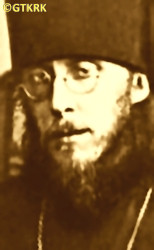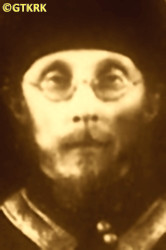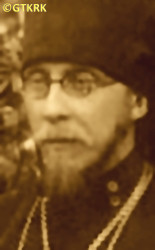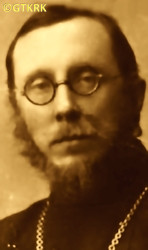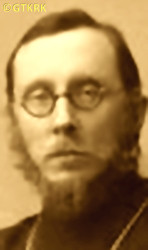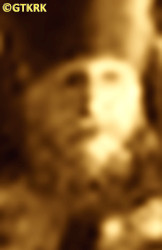Roman Catholic
St Sigismund parish
05-507 Słomczyn
85 Wiślana Str.
Konstancin deanery
Warsaw archdiocese, Poland
full list:
displayClick to display full list

searchClick to search full list by categories
wyświetlKliknij by wyświetlić pełną listę po polsku

szukajKliknij by przeszukać listę wg kategorii po polsku

Martyrology of the clergy — Poland
XX century (1914 – 1989)
personal data
surname
SZARAPOW
forename(s)
Constantine (pl. Konstanty)
religious forename(s)
Tikhon (pl. Tichon)

function
archbishop
creed
Eastern Orthodox Church ORmore on
en.wikipedia.org
[access: 2014.09.21]
diocese / province
Alma‐Ata‐Turkestan OR eparchymore on
drevo-info.ru
[access: 2024.01.26]
Cherepovets OR eparchymore on
drevo-info.ru
[access: 2024.01.26]
Gomel OR eparchymore on
drevo-info.ru
[access: 2024.01.26]
Volyn OR eparchy (Polish Autocephalous Orthodox Church PAOC)more on
pl.wikipedia.org
[access: 2021.12.19]
Volyn OR eparchy
nationality
Russian
date and place
of death
10.11.1937

Zhanalyktoday: Kainar ssov., Talgar dist., Almaty reg., Kazakhstan
more on
ru.wikipedia.org
[access: 2024.03.19]
alt. dates and places
of death
Alma‐Ataform.: Verny
today: Almaty, Almaty reg., Kazakhstan
more on
en.wikipedia.org
[access: 2020.07.31]
details of death
During World War I 1914‐1918, chaplain of the Army of the Russian Empire. Initially a hospital chaplain (probably in Kremyenets), later a chaplain in the active army — 177th Izobor Infantry Regiment.
On c. 01.03.1919, while staying in Zdolbuniv and publishing the Orthodox magazine „Orthodoxy”, arrested by officers of the Ukrainian People's Republic UPR (under the leadership of Simon Petlura), which on 22.01.1918 declared the independence of Ukraine and controlled Zdolbuniv till c. 13.08.1919. The magazine and the printing house were closed.
Deported to the Uniate monastery of Basilian Fathers' in Buchach in Eastern Galicia. Released on c. 01.06.1919 (a month before Poland took control of the town).
Returned to Zdolbuniv and resided there during the Polish–Russian war of 1919‐1921. Remained there — then in independent Poland — after the Russian defeat in the Battle of Warsaw on c. 15.08.1920 (called the „Miracle on the Vistula”).
Protested against the autocephaly of the Orthodox Church in Poland and the establishment of the Polish Autocephalous Orthodox Church PAOC. As a result, on 30.06.1924, deprived of the position of rector of the monastery in Zhyrovitsy, apparently at the request of the Polish Ministry of Religious Denominations and Public Enlightenment.
On 15.10.1924 summoned to Warsaw and on 17.10.1924 expelled from Poland by the authorities.
After two months in Berlin, on 17.01.1924, returned to Russia, to Moscow.
On 16.05.1925 arrested in Gomel by agents of the criminal Russian organization GPU, on charges of „appropriating administrative rights and issuing administrative orders in the Gomel eparchy without the permission of the authorities”.
Imprisoned in Mogilev, and later in Minsk. 21.05.1925 formally expelled from Gomel and transported to Moscow, without the right to leave this city.
There, on 30.11.1925, arrested again. The arrest took place after the death of the Russian Patriarch, Tikhon, on 07.04.1925, when his successor — Lat. locum tenens (Eng. „holding the reins”), i.e. acting („ad interim”) Patriarch — Abp Peter Polański, was forced by the Bolsheviks to show loyalty to the communist state and the so‐called „Living Church” movement collaborating with the Bolsheviks, a schismatic movement to the liquidation of which he significantly contributed in Gomel.
Held in Butyrki prison in Moscow.
On 21.05.1926 tried in Moscow by the kangaroo court of the OGPU criminal organisation, on charges of „maintaining contacts with foreign countries, informing Metropolitan Peter Polański about the activities of monarchists” and Art. 62 of the Penal Code. Sentenced to three years of imprisonment in a concentration camp. Due to health condition, the sentence was commuted for three years of exile.
From 06.1926 resided in the town of Chimboy in the Karakalpakstan region in Uzbekistan.
There, on 20.06.1927 arrested again. Held prob. in Chimboy prison.
On 08.08.1927 again appeared before the OGPU kangaroo court, accused of „distributing criminal appeals among the faithful of the Gomel eparchy, as well as in Uzbekistan, where was in exile, in which pointed to persecutions allegedly organized by the Russian authorities”. Convicted under Art. 58‐17 of the Penal Code for three years in a concentration camps.
Through the Butyrki prison in Moscow, in 12.1927 transported to the ITL SLON concentration camp on the Solovetsky Islands in northern Russia.
Slaved as a night watchman at the local historical museum, and then (during the typhus epidemic) helped as a doctor.
At the end of this „punishment”, arrested again and, pursuant to Art. 58‐10 of the Penal Code, sentenced to three years of exile.
In 07.1930 transported to Arkhangelsk on the White Sea in northern Russia.
There, on 13/23.01.1931, arrested again. Kept in custody in Arkhangelsk.
On 31.08.1931, once again appeared before the Russian OGPU kangaroo court, accused of „participating in a counter–revolutionary group of clergy in exile in Arkhangelsk”. Persuant of Art. 58‐10 of the Penal Code sentenced to another three years of imprisonment in a concentration camp and subsequent exile.
Transported to the ITL SibLag slave labor concentration camp, to the town of Mariinsk in the Kemerovo region.
On 02.12.1931, tried again by the OGPU kangaroo court and sentenced to 3 years of exile. Transported back to the north of Russia, to the Northern Krai, with its capital in Arkhangelsk.
On 07.03.1932, exiled to Kazakhstan — resided in Samarakantska village in the Karaganda region.
In 1934 released from exile — went to Ryazan to take over the eparchy that had been entrusted to him, but there arrested again and sent back to Kazakhstan.
After release on 09.01.1937 moved to Alma–Ata.
On the night of 18‐19.08.1937, during the so‐called Great Purge, i.e. the genocidal extermination of „enemies of the Russian state”, arrested for the last time.
Jailed in Alma–Ata prison.
On 17.10.1937 tried by the genocidal Russian «NKVD Troika» kangaroo court, on charges of „espionage activities for foreign intelligence, agitation aimed at discrediting the leaders of the Russian Bolshevik Party and the Russian government, preparing terrorist acts against the leaders of the Bolshevik Party, supporting monarchism”.
Sentenced to death and murdered in one of the ravines near Alma–Ata.
cause of death
murder
perpetrators
Russians
sites and events
Great Purge 1937Click to display the description, ITL SibLagClick to display the description, ITL SLONClick to display the description, Forced exileClick to display the description, Moscow (Butyrki)Click to display the description, Polish‐Russian war of 1919‐1921Click to display the description, Polish‐Ukrainian war of 1918‐1919Click to display the description
date and place
of birth
19.04.1886

Tulatoday: Tula city reg., Tula oblast, Russia
more on
en.wikipedia.org
[access: 2021.04.02]
alt. dates and places
of birth
07.04.1886
parents
SZARAPOW John
🞲 ?, ? — 🕆 ?, ?

🞲 ?, ? — 🕆 ?, ?
presbyter (holy orders)
ordination
10.01.1912

positions held
1937
archbishop — Russian Orthodox Church — dignity conferment
from 17.07.1936
bishop — Alma‐Ataform.: Verny
today: Almaty, Almaty reg., Kazakhstan
more on
en.wikipedia.org
[access: 2020.07.31] ⋄ Alma‐Ata‐Turkestan OR eparchy — practically the eparchy took over in 17.01.1937
21.05.1934
auxiliary bishop — vicariate ⋄ Ryazan‐Shatsk OR eparchy — appointment (prob.), eparchy not taken over
17.03.1934 – 21.05.1934
auxiliary bishop — Cherepovetstoday: Cherepovets city reg., Volgograd oblast, Russia
more on
en.wikipedia.org
[access: 2024.01.26] ⋄ vicariate ⋄ Novgorod OR eparchy — appointment, the eparchy not taken over and the nomination withdrawn
22.03.1925 – 17.03.1934
auxiliary bishop — Gomeltoday: Gomel dist., Gomel reg., Belarus
more on
en.wikipedia.org
[access: 2021.09.17] ⋄ vicariate ⋄ Mogilev OR eparchy — as bishop of the Gomel vicariate of the Mogilev Eparchy, fought the so‐called the „Renovationist” movement („Living Church”), which announced the establishment of an independent Gomel eparchy — overcame the schism, but it seems that the concept of an independent Gomel eparchy survived, and hence is sometimes referred to as the Ordinary Bishop of Gomel; due to the arrests from 06.1925 to 10.12.1925 ruled from Moscow, later was held in prisons and in exile; also: from 30.03.1925, spiritual guardian of Orthodox believers in Poland not recognising the Polish Autocephalous Orthodox Church PACP and remaining in the Russian Orthodox Church
22.03.1925
Bishop — Moscowtoday: Moscow city, Russia
more on
en.wikipedia.org
[access: 2020.07.31] ⋄ Forty Martyrs of Sebaste OR church ⋄ OR monastery (Novospassky) — bishop's cheirotonia, i.e. ordination
1924
chaplain — Zhirovichitoday: Zhirovichi ssov., Slonim dist., Grodno reg., Belarus
more on
be.wikipedia.org
[access: 2022.11.09] ⋄ St George OR church (cemetery)
08.02.1922 – 30.06.1924
rector — Zhirovichitoday: Zhirovichi ssov., Slonim dist., Grodno reg., Belarus
more on
be.wikipedia.org
[access: 2022.11.09] ⋄ Polish Autocephalous Orthodox Church PACP ⋄ Assumption of the Blessed Virgin Mary OR monastery — also: commissioner for the Orthodox Church in Poland, dean of monasteries of the Grodno eparchy and Byton district, member of the Warsaw Church Council
08.02.1922
Archimandrite, i.e. superior abbot — Moscowtoday: Moscow city, Russia
more on
en.wikipedia.org
[access: 2020.07.31] ⋄ Russian Orthodox Church — dignity conferment
1919 – 1922
priest — Zdolbunivtoday: Zdolbuniv hrom., Rivne rai., Rivne obl., Ukraine
more on
en.wikipedia.org
[access: 2021.09.17] ⋄ Dormition of the Mother of God OR church (Pochaiv Lavra) ⋄ Pochaivtoday: Pochaiv urban hrom., Kremenets rai., Ternopil obl., Ukraine
more on
en.wikipedia.org
[access: 2020.09.27], OR parish
1918 – 1919
monk — Zdolbunivtoday: Zdolbuniv hrom., Rivne rai., Rivne obl., Ukraine
more on
en.wikipedia.org
[access: 2021.09.17] ⋄ Assumption of the Blessed Virgin Mary OR monastery — also: organizer of the Orthodox brotherhood, publisher and editor of the magazine "Prawosławie"
c. 1914 – c. 1917
chaplain — Imperial Russian Army
from 08.1914
monk — Kremenetstoday: Kremenets urban hrom., Kremenets rai., Ternopil obl., Ukraine
more on
en.wikipedia.org
[access: 2020.10.18] ⋄ Epiphany of the Lord OR monastery — sent with the task of taking steps to incorporate the Uniates into Orthodoxy, which was interrupted by the course of World War I
10.01.1912
hieromonk — Pochaivtoday: Pochaiv urban hrom., Kremenets rai., Ternopil obl., Ukraine
more on
en.wikipedia.org
[access: 2020.09.27] ⋄ Russian Orthodox Church ⋄ Dormition of the Mother of God OR monastery (Pochaiv Lavra) — priesthood cheirotonia, i.e. ordination, on 01.01.1912 preceded by deacon cheirotonia
31.06.1911
monastic tonsure — Pochaivtoday: Pochaiv urban hrom., Kremenets rai., Ternopil obl., Ukraine
more on
en.wikipedia.org
[access: 2020.09.27] ⋄ Russian Orthodox Church ⋄ Dormition of the Mother of God OR monastery (Pochaiv Lavra)
1911 – 08.1914
monk — Pochaivtoday: Pochaiv urban hrom., Kremenets rai., Ternopil obl., Ukraine
more on
en.wikipedia.org
[access: 2020.09.27] ⋄ Russian Orthodox Church ⋄ Dormition of the Mother of God OR monastery (Pochaiv Lavra) — deputy editor of the magazine „Russian Monk”, published by the printing house of the „Typographic Brotherhood”
13.08.1904 – 1911
monk — Zhabyntoday: Boloto, Belyov reg., Tula oblast, Russia
more on
ru.wikipedia.org
[access: 2024.01.26] ⋄ Presentation of the Blessed Virgin Mary hermitage of the monk Macarius — independent student of theology and philosophy at the level of the Orthodox Theological Academy
13.08.1904
rassophore — Zhabyntoday: Boloto, Belyov reg., Tula oblast, Russia
more on
ru.wikipedia.org
[access: 2024.01.26] ⋄ Presentation of the Blessed Virgin Mary hermitage of the monk Macarius — granting the right to wear a ryasa (a robe resembling a floor–length cloak, slit at the front and fastened at the neck, with long, wide sleeves, most often in black), klobuk (headgear) and a belt, name (Tikhon), and admission to the monastic community
from 24.10.1902
novitiate — Zhabyntoday: Boloto, Belyov reg., Tula oblast, Russia
more on
ru.wikipedia.org
[access: 2024.01.26] ⋄ Presentation of the Blessed Virgin Mary hermitage of the monk Macarius
sites and events
descriptions
Great Purge 1937: „Great Terror” (also «Great Purge», also called „Yezhovshchyna” after the name of the then head of the NKVD) — a Russian state action of political terror, planned and directed against millions of innocent victims — national minorities, wealthier peasants (kulaks), people considered opponents political, army officers, the greatest intensity of which took place from 09.1936 to 08.1938. It reached its peak starting in the summer of 1937, when Art. 58‐14 of the Penal Code about „counter‐revolutionary sabotage” was passed , which became the basis for the „legalization” of murders, and on 02.07.1937 when the highest authorities of Russia, under the leadership of Joseph Stalin, issued a decree on the initiation of action against the kulaks. Next a number of executive orders of the NKVD followed, including No. 00439 of 25.07.1937, starting the liquidation of 25,000‐42,000 Germans living in Russia (mainly the so‐called Volga Germans); No. 00447 of 30.07.1937, beginning the liquidation of „anti‐Russian elements”, and No. 00485[2] of 11.08.1937, ordering the murder of 139,835 people of Polish nationality (the latter was the largest operation of this type — encompassed 12.5% of all those murdered during the «Great Purge», while Poles constituted 0.4% of the population). In the summer of 1937 Polish Catholic priests held in Solovetsky Islands, Anzer Island and ITL BelbaltLag were locked in prison cells (some in Sankt Petersburg). Next in a few kangaroo, murderous Russian trials (on 09.10.1937, 25.11.1937, among others) run by so‐called «NKVD Troika» all were sentenced to death. They were subsequently executed by a single shot to the back of the head. The murders took place either in Sankt Petersburg prison or directly in places of mass murder, e.g. Sandarmokh or Levashov Wilderness, where their bodies were dumped into the ditches. Other priests were arrested in the places they still ministered in and next murdered in local NKVD headquarters (e.g. in Minsk in Belarus), after equally genocidal trials run by aforementioned «NKVD Troika» kangaroo courts.
ITL SibLag: Russian Rus. Исправи́тельно‐Трудово́й Ла́герь (Eng. Corrective Labor Camp) ITL Rus. Сибирский (Eng. Siberian) — concentration and slave forced labor camp (within the Gulag complex) — headquartered in Mariinsk in Kemerovo Oblast, where a central camp for invalids was also operational (moved twice to Novosibirsk, c. 350 km away). Founded in 1929. One of the largest — initially spread over large area from Omsk to Krasnoiarsk, as a matter of fact whole Western Siberian Plain, next subdivided and limited to Novosibirsk, Tomsk and Kemerovo oblasts. Up to 80,000 inmates were held in SibLag: e.g. 78,838 (01.01.1938); 77,919 (01.01.1942); 70,370 (01.04.1942). Prisoners slaved at railroad construction, forestry, carpentry and in coal mines, and other industrial branches (brick, clothing, leather and fur factories and plants). Closed down in c. 1960. (more on: tspace.library.utoronto.caClick to attempt to display webpage
[access: 2018.09.02], www.gulagmuseum.orgClick to attempt to display webpage
[access: 2014.05.09])
ITL SLON: Russian Rus. Исправи́тельно‐Трудово́й Ла́герь (Eng. Corrective Labor Camp) ITL Rus. Солове́цкий ла́герь осо́бого назначе́ния Ла́герь (Eng. Solovetsky Special Purpose Camp) SLON — concentration and slave forced labor camp (within what was to become Gulag complex) — headquartered in Solovetsky Islands in Arkhangelsk Oblast. Founded on 13.10.1923 in a famous Orthodox monastery. In the 1920s, one of the first and largest concentration camps in Russia. The place of slave labor of prisoners — at forest felling, sawmills, peat extraction, fishing, loading work on the Murmansk Railway Main Line, in road construction, production of food and consumer goods, at the beginning of the construction of the White Sea ‐ Baltic canal, etc. The concept of the later system of Russian Gulag concentration camps prob. had its origins in the Solovetsky Islands camp — from there the idea spread to the camps in the area covered by the construction of the White Sea ‐ Baltic canal, i.e. ITL BelBaltLag, and from there further, to the entire territory of the Russian state. From the network of camps on the Solovetsky Islands — also called the Solovetsky Islands archipelago — prob. also comes the concept of the „Gulag Archipelago” created by Alexander Solzhenitsyn. It is estimated that tens to hundreds of thousands of prisoners passed through the Solovetsky Islands concentration camps. At its peak, c. 72,000 prisoners were held there: e.g. 14,810 (12.1927); 12,909 (03.1928); 65,000 (1929); 53,123 (01.01.1930); 63,000 (01.06.1930); 71,800 (01.01.1931); 15,130 (1932); 19,287 (1933) — c. 43,000 of whom were murdered, including the years 1937‐1938 when c. 9,500 prisoners were transported from the camp and murdered in several places of mass executions, including Sandarmokh, Krasny Bor and Lodeynoye Polye. Among them were many Catholic and Orthodox priests. After the National Socialist Party came to power in Germany in 1933, a German delegation visited the ITL SLON camp, to „inspect” Russian solutions and adopt them later in German concentration camps. It operated until 04.12.1933, with a break from 16.11.1931 to 01.01.1932, when it was part of and later became a subcamp of the ITL BelBaltLag camp. It operated as such until 1939 (from 1936 as a prison). (more on: old.memo.ruClick to attempt to display webpage
[access: 2024.04.08])
Forced exile: One of the standard Russian forms of repression. The prisoners were usually taken to a small village in the middle of nowhere — somewhere in Siberia, in far north or far east — dropped out of the train carriage or a cart, left out without means of subsistence or place to live. (more on: en.wikipedia.orgClick to attempt to display webpage
[access: 2014.12.20])
Moscow (Butyrki): Harsh transit and interrogation prison in Moscow — for political prisoners — where Russians held and murdered thousands of Poles. Founded prob. in XVII century. In XIX century many Polish insurgents (Polish uprisings of 1831 and 1863) were held there. During Communist regime a place of internment for political prisoners prior to a transfer to Russian slave labour complex Gulag. During the Great Purge c. 20,000 inmates were held there at any time (c. 170 in every cell). Thousands were murdered. (more on: en.wikipedia.orgClick to attempt to display webpage
[access: 2020.05.01])
Polish‐Russian war of 1919‐1921: War for independence of Poland and its borders. Poland regained independence in 1918 but had to fight for its borders with former imperial powers, in particular Russia. Russia planned to incite Bolshevik‐like revolutions in the Western Europe and thus invaded Poland. Russian invaders were defeated in 08.1920 in a battle called Warsaw battle („Vistula river miracle”, one of the 10 most important battles in history, according to some historians). Thanks to this victory Poland recaptured part of the lands lost during partitions of Poland in XVIII century, and Europe was saved from the genocidal Communism. (more on: en.wikipedia.orgClick to attempt to display webpage
[access: 2014.12.20])
Polish‐Ukrainian war of 1918‐1919: One of the wars for borders of the newly reborn Poland. At the end of 1918 on the former Austro‐Hungarian empire’s territory, based on the Ukrainian military units of the former Austro‐Hungarian army, Ukrainians waged war against Poland. In particular attempted to create foundation of an independent state and attacked Lviv. Thanks to heroic stance of Lviv inhabitants, in particular young generation of Poles — called since then Lviv eaglets — the city was recaptured by Poles and for a number of months successfully defended against furious Ukrainian attacks. In 1919 Poland — its newly created army — pushed Ukrainian forces far to the east and south, regaining control over its territory. (more on: en.wikipedia.orgClick to attempt to display webpage
[access: 2017.05.20])
sources
personal:
drevo-info.ruClick to attempt to display webpage
[access: 2024.01.26], ru.wikipedia.orgClick to attempt to display webpage
[access: 2024.01.26], kuz1.pstbi.ccas.ruClick to attempt to display webpage
[access: 2024.01.26]
bibliographical:
„Hierachy, clergy and employees of the Orthodox Church in the 19th‐21st centuries within the borders of the Second Polish Republic and post–war Poland”, Fr Gregory Sosna, M. Antonine Troc-Sosna, Warsaw–Bielsk Podlaski 2017
original images:
www.booksite.ruClick to attempt to display webpage
[access: 2024.01.26], commons.wikimedia.orgClick to attempt to display webpage
[access: 2024.01.26], minds.byClick to attempt to display webpage
[access: 2024.01.26], drevo-info.ruClick to attempt to display webpage
[access: 2024.01.26], monasterium.byClick to attempt to display webpage
[access: 2024.01.26], kuz1.pstbi.ccas.ruClick to attempt to display webpage
[access: 2024.01.26], pl.wikipedia.orgClick to attempt to display webpage
[access: 2024.01.26]
LETTER to CUSTODIAN/ADMINISTRATOR
If you have an Email client on your communicator/computer — such as Mozilla Thunderbird, Windows Mail or Microsoft Outlook, described at WikipediaPatrz:
en.wikipedia.org, among others — try the link below, please:
LETTER to CUSTODIAN/ADMINISTRATORClick and try to call your own Email client
If however you do not run such a client or the above link is not active please send an email to the Custodian/Administrator using your account — in your customary email/correspondence engine — at the following address:

giving the following as the subject:
MARTYROLOGY: SZARAPOW Constantine
To return to the biography press below:
 Click to return to biography
Click to return to biography









